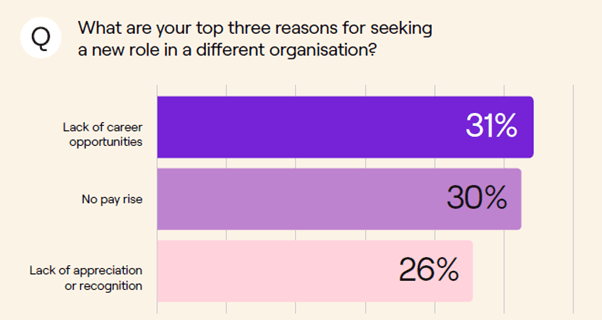13 Ways to drastically improve your hiring selection process
Hiring the wrong person can cost your business at least 30% of your new employee’s salary. Nailing your selection process will help save you time and money down the track. Before we dive into how to improve the selection process, we need to better understand the difference between attraction and selection. Simply put, attraction is…
Hiring the wrong person can cost your business at least 30% of your new employee’s salary. Nailing your selection process will help save you time and money down the track.
Before we dive into how to improve the selection process, we need to better understand the difference between attraction and selection.
Simply put, attraction is how you persuade a job seeker to apply to your job vacancy. This involves what you post and where you post it. This is not limited to job ads on SEEK or social media. You might reach out to candidates via email or through LinkedIn messages to tell them you have a vacancy. This is the first step of the recruitment process.
Selection is how you choose the right candidate for the job. This involves checking resumes, phone screening, interviews, testing, reference checking, and background checking.
Both attraction and selection go hand in hand. A great attraction strategy will increase the quality of applicants and a great selection strategy will ensure you select the right candidate.
Let’s look at how to improve your hiring process more deeply:
1. Consider where you are sourcing your candidates
Posting to platforms where your target market lives will be your best bet for finding suitable candidates fast. Some candidates will be on LinkedIn, while others might be easier to find on Facebook. It is also a good idea to make the most of job boards such as SEEK, CareerOne, Jora and Indeed. Candidate numbers vary across different job boards, for example, CareerOne has a larger number of Trades & Services and Healthcare users than Insurance.
Make sure to categorise your job ad correctly and use job titles that are widely used, such as ‘Customer Service Officer’, instead of ‘Customer Service Ninja’. This will help job board algorithms match your role to the right candidates via job alerts and other notifications.
Another source is passive candidates – those who are not actively looking for a new job but would consider one anyway. Reach out to people on LinkedIn who have the same job title that you are hiring for or have the same experience that matches your criteria.
2. Tailor your job description to attract only suitable applicants
An effective job description will save you from reading hundreds of CVs from unsuitable applicants.
First, you need to know who it is you’re looking for and what it is you are offering. That way, you can write a clear description. Make sure to mention benefits, talk about company highlights, detail what the person will do and what they need to be a suitable candidate.
You want to sell the job. This is a two-way street.
Did you know research suggests that women feel they need to meet 100% of the job requirements before they apply to a job, while men feel they only need to meet 60%? This highlights the importance of limiting the requirements section to essential requirements only. Do not state ‘Forklift licence required’ if you are willing to help the right candidate obtain this.
Top tip: Do not specify ‘X years’ experience required’ in your ad. This may deter candidates who don’t have the years’ experience but have all the right skills and knowledge!
3. Keep your business’s goals and objectives in mind
This will help throughout multiple stages of the recruitment process. Keep the goals of the business in mind when you craft your job description, create the list of qualities candidates need, during the interview, while choosing testing and when completing reference checks.
4. Ask for advice from your network or colleagues
If you don’t know what you’re looking for or you need help deciding what skills/qualities are required, ask people who work in similar roles or teams. These people will know what qualities the new employee will need to perform well in the role.
Ask those who will be working with the new employee what type of person they are looking for. They will know firsthand what skills are missing from their team or what skills will complement the team to achieve their goals and perform well.
You might ask them to join in on interviews or have a look over some CVs with you.
5. Consider diverse experience
Make your selection process easier by being open-minded. According to a recent study by Employment Hero, 1 out of 3 job seekers will consider looking for a new role outside of their current industry. This is the perfect opportunity for employers, like yourself, to introduce new perspectives and ideas into the business – which is key to innovation.
Consider transferrable skills or hire for attitude where skills can be taught. This leads us to our next point.
6. Hire for attitude and train skills
Especially for entry-level roles, hiring for attitude will give you a bigger pool to select from. Skills can be taught, but attitude is a reflection of personality and is unlikely to change. You can find someone with a great attitude by assessing their personality through tests and paying attention to their mannerisms in interviews.
Benefits of hiring for attitude are endless.
Communicate learning and development as a benefit of the role; this perk can be used to retain candidates’ interest throughout the recruitment process.
When you hire for attitude and train an employee to possess new skills, you show that you value them. 26% of people surveyed by Employment Hero stated that lack of appreciation or recognition was the third top driver for why they are leaving their roles for a new organisation, after lack of career opportunities and no pay rise.

Source: Employment Hero, November 2021
Hire a person who has a positive attitude and is willing to learn. You’ll find that you have chosen an employee who is engaged and is dedicated to performing well.
7. Don’t forget the candidate experience
Your brand is represented by your recruitment process . Imagine finding a great candidate but losing them before you make an offer because you gave a poor candidate experience.
Improve your candidate experience through regular and transparent communication during the recruitment process. For example, after an interview, let them know what the next steps are and when they should expect to hear from you next. With that in mind, you should try to make the whole recruitment process as fast as possible, or you risk losing a great candidate to your competitors.
Ensure the information and details you provide the candidate are accurate. For example, the correct link to the online video or the correct address for the interview location.
Don’t forget basic etiquette. Spell their name correctly, give them your full attention in interviews and reply to all their messages.
8. Streamline your selection process to eliminate biases
Document your selection process and stick to it. The process needs to be the same for every applicant. Using the same interview questions, selection criteria and testing will ensure you can compare apples to apples.
Having this documented will give you something to reflect on when you’re looking to improve aspects of your process.
9. Use testing or create a task for the candidate to help you assess their abilities
To further remove biases, use an objective approach when assessing candidates. For example, personality tests provide insights as to how applicants personalities will impact their workplace behaviour. Or ask candidates to complete a relevant task, such as writing a blog or role play in a sales simulation. Design tasks or testing that best allows you to assess specific qualities the candidate needs to possess.
Make sure all applicants for the same job complete the same testing or assessments.
10. Save yourself time by phone screening applicants first
- Rather than progressing all potential candidates straight to a face to face interview, consider phone screening using basic questions to help you determine any unsuitable applicants quickly. Screening questions should include:
- This is a full-time position; will you be available to work full time?
- Tell me a bit about your experience as a [position title] and why you’re looking for a new role
- Tell me a bit about yourself
- Ask about any potential red flags on their CV e.g. short tenures
Phone screening is also a good way to quickly assess a person’s speaking and communication abilities if you’re looking for someone with great speaking skills.
Top tip: Don’t forget to determine the candidate’s commute and salary expectations in the initial phone screen. Long commutes are generally not sustainable, and you don’t want to waste your time on a candidate who has far higher salary expectations than you intended for the role.
11. Confirm that you’ve made the right decision by conducting reference checks
References help you learn a candidate’s proven work experience and behaviour, beyond what they will sell you in an interview.
Ask candidates for contacts details of at least two previous managers. Call the references to learn how this person performed in their role. Ask what management style worked best and gain a deeper understanding of the way they worked and what motivated them. You can have a look at our reference checking guide here .
Top tip: Ask the candidate to give their referees a heads up! You’ll complete the references faster and you won’t end up with any angry, unexpected responses! They’ll also be more likely to provide more detail about the candidate.
12. Collect feedback from candidates and through reviews
Successful applicants may give you biased feedback because they successfully made it through. Candidates who were unsuccessful may be biased too but they would be more likely to give you critical feedback about your process. Ask candidates what they thought about the process and what they think could have improved their experience.
At Fuse, we use a review platform, Sourcr , to collect reviews from our clients and candidates. The reviews are a great branding tool and help us collect feedback in a way that is automated, seamless, and easy.
Candidates who quickly leave after starting a new role are also great people to ask for feedback – depending on why they left. A candidate leaving shortly after starting might mean there is a flaw in your selection process. You can ask them about it in their exit interview. Ensure you complete onboarding interviews for all new starters. This will help improve the process for future employees and ultimately improve retention!
Don’t forget to actually take on the feedback. There is no point in asking for advice and then ignoring it. There is always potential to improve!
13. Consider promoting internally
Referring back to Employment Hero’s report regarding Employee Movement and Retention , giving employees the opportunity to progress their career will motivate them to stay in your organisation. What’s the benefit of having a great selection process if you struggle to retain those you select?
An employee will already know how the business works; they know your culture and your objectives. All you need to provide is further training. In some cases, this is training you would have needed to do anyway, on top of inductions and onboarding, for a new employee.
Think about who has a great attitude, is a keen learner and is performing well in their role.
At Fuse, we work with our clients to represent their recruitment process positively in the market. We’ve been building our networks for 11 years and have recruiter-specific technology that helps us dive deep into the passive candidate market.
If you have vacancies in your business, we’re here to help. Fill out the form on this page and one of our consultants will be in contact shortly.







